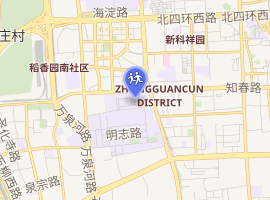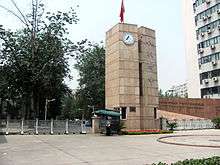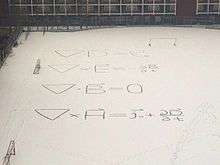High School Affiliated to Renmin University of China
The High School Affiliated to Renmin University Of China (simplified Chinese: 中國人民大學附屬中學; traditional Chinese: 中国人民大学附属中学; pinyin: Zhōngguó Rénmín Dàxué Fùshŭ Zhōngxué),[lower-alpha 1] known colloquially as Rendafuzhong (RDFZ), is the high school affiliated with Renmin University of China. RDFZ is situated in the Haidian District of Beijing, within the Zhongguancun Science and Technology Zone. RDFZ is a beacon high school accredited by the Beijing Municipal Commission of Education. The school is a member of the G30 Schools group. A 2016 Organisation for Economic Co-operation and Development (OECD) report described the school as among the most famous in China.[2]
| The High School Affiliated to Renmin University of China 中国人民大学附属中学 | |
|---|---|
 | |
| Address | |
37 Zhongguancun Street | |
| Information | |
| Other names | RDFZ (人大附中) Rendafuzhong |
| Type | Public |
| Motto | 崇德,博学,创新,求实 (Virtue, Erudition, Creativity and Factualism) |
| Established | April 3, 1950 |
| CEEB code | 694270 |
| Principal | Liu Xiaohui (刘小惠) |
| Principal Emeritus | Liu Pengzhi (刘彭芝) |
| Enrollment | 4,500 (2018) |
| Campus size | 142 acres (57 ha)[1] |
| Campus type | Urban |
| Color(s) | Red and White |
| Rival | Beijing No. 4 High School, Beijing Bayi School |
| Affiliations | Renmin University of China |
| Website | www |

| |

History
The school was established on April 3, 1950 as the Beijing Experimental Accelerated Middle School for Workers and Farmers (北京实验工农速成中学);[3] though plans to create an experimental school for Beijing's growing population existed as early as January of that year. Created by the Chinese Ministry of Education, which had been formally established only a year earlier, the school was used to further develop China's education system.
In 1952, the school became affiliated with Renmin University of China and was renamed to Workers and Farmers' Accelerated Middle School Attached to Renmin University of China (中国人民大学附设工农速成中学). In 1955, the school broadened its student population beyond workers and farmers and broadened its curriculum to include traditional high school classes.[4] In 1956, the school was again renamed, this time to Workers' and Farmers' High School Affiliated to Renmin University of China (中国人民大学附属工农中学),[5] a name that was kept until 1960, when the name was finally changed to its current name, the High School Affiliated to Renmin University of China.[5]
With Renmin University of China closed by the Beijing Revolutionary Committee during the Cultural Revolution in October 1970,[6] the school briefly changed its name to Beijing Middle School No. 172.[7] When Renmin University of China reopened in 1978, the school reaffirmed its affiliation to the university and the school's name was changed back.[8]
A 2012 article in The New York Times alleged that the school was one of many in China to illegally accept bribes to admit students; however, this claim was denied by school officials.[9]
Structure
Administration
The school is under the administration of and accredited by the Beijing Municipal Commission of Education.
The school is also branch of RDFZ United,[10] an administrative body presiding over a number of schools internationally. Besides RDFZ, there are more than ten schools under the administration of RDFZ United.[10] RDFZ United is one of the few Chinese educational organizations that have branches located outside mainland China; Princeton International School of Mathematics and Science, created by a joint venture between Chinese investor Jiang Bairong and RDFZ,[11] is a member of RDFZ United located in Princeton, New Jersey.[12]
Staff
The staff includes 50 special-class teachers and over 170 senior-level teachers. 16 teachers have been conferred the title of "pillar teacher" at the national level, and another 25 at the Beijing municipal level. 37 are recognized as advanced individuals in their disciplines in Haidian District. There are more than 40 foreign teachers from the United States, the United Kingdom and other countries.[13]
| Term | Name |
|---|---|
| Hu Chaozhi (胡朝芝) | 1950–1956 |
| Xia Jia (夏加) | 1956–1959 |
| Di Wenyu (邸文彧) | 1960–1962 |
| Chen Bangyou (陈邦友) | 1967–1969 |
| Wu Yingjie (吴英杰) | 1971–1978 |
| Dong Fang (董放) | 1983–1984 |
| Hu Junze (胡俊泽) | 1984–1992 |
| Zhu Disheng (朱迪生) | 1992–1997 |
| Liu Pengzhi (刘彭芝) | 1997–present |
| Zhai Xiaoning (翟小宁) | 2014–2019 |
| Liu Xiaohui (刘小惠) | 2019–present |
Students
Foreign passport holders are allowed to attend so long as they have legal guardians residing in Beijing for the duration of their enrollment.[15]
Academics
RDFZ is a beacon high school accredited by the Beijing Municipal Commission of Education. In a 2016 ranking, it ranked first amongst all high schools in Mainland China.[16] In another 2016 ranking, this time of Chinese high schools that send students to study in American universities, RDFZ ranked fifth in mainland China by number of students entering top American universities.[17][18] The school is a member of the G30 Schools group.[19] The school offers the International Baccalaureate diploma[20] , Advanced Placement and A-Level curriculums. RDFZ has been awarded a number of titles and awards by China's Ministry of Education and by the Beijing Municipal Commission of Education, including:
- Advanced School of All-round Education with Distinctive Characteristics
- School of Full-range Development and Talented Students' Academic Training
- Advanced School of Working Skill Education
- Municipal Model School for Education in Science and Technology
- National Model School for Modern Technology Education
- Excellent School for Training Elite Back-up Athletes
- Advanced School for Merits in Physical and Health Work
- Model School for Demonstrating Green Network
- State-level Traditional School for Physical Education
Departments
There are two academic departments in RDFZ:
- Domestic curriculum centre (本部): offering junior high (Grade 7-9) and senior high (Grade 10-12) students domestic curriculums prescribed by the ministry of education and Beijing's department of education. The graduating students of junior high and senior high will take Zhongkao and Gaokao for senior high school and university admission respectively.
- International curriculum centre (ICC, 国际课程中心): ICC offers foreign-bound senior high students (Grade 10-12) a variety of internationally recognised curriculums (IB, AP, and A-Level) and helps students gain admissions into international colleges (predominantly U.K., U.S., Canadian, and Australian universities).
It is notable that, not to be confused with ICC, RDFZ also has an international student office (ISO, 国际部) that places foreign nationals (students holding non-PRC passports) into domestic and international curriculums.
Admissions
Junior High School
Due to the lack of standard test, junior high school admission in Beijing is usually complicated and not without controversies. Admitted junior high school (初中) students usually come from one of the following admission programs:
- Random Placement (随机派位): a lottery program is administered for eligible Grade 6 students living in the school district. However, due to the merit-based nature of the school and the conceivably high level of academic demand, the quota for the lottery program is usually very small, accounting for less than 10 percent of the incoming class.[21]
- Early Development Program (EDP, 早培): EDP is targeted to academically-gifted and precocious Grade 5 students. RDFZ administers a separate entrance exam (including Chinese, English, Math and Science). And the students go through an accelerated curriculum that will enable them graduate one year earlier than usual.
- Talent Program (特长生): students with special talent in Music, Art, Sports and Science are admitted through this program.
- Regular Placement (统招): students are assessed by their academic and extracurricular achievements in primary school. This is the largest entrance program by the number of students.
- Feeder Schools (生源校): RDFZ also assigns special quota to its feeder schools (e.g. The Elementary School Affiliated to Renmin University of China).
- Discretionary Placement (条子生): Although never publicly confirmed and often vehemently denied by the school officials, there has been reports that RDFZ admits students with political and business ties.[22][9]
Senior High School
Admitted senior high school (高中) students usually come from one of the following admission programs:
- High School Entrance Exam (Zhongkao, 中考): a majority of the senior high class is admitted based on the candidate's Zhongkao score.
- Direct Entry (直升): Within the RDFZ system, students with perfect grades in their junior high career are offered unconditional admission to the senior high school; junior high students with less than perfect grades are sometimes offered conditional admissions (if the student can achieve a certain score in Zhongkao).
- EDP: Barring exceptional circumstance, all EDP students are offered direct entries to senior high.
University Admission Result
Since the turn of the 21st century, RDFZ has been sending the highest number of graduates to Peking University and Tsinghua University (the top 2 universities in China) in Beijing.[23] The dominance peaked in 2009 Gaokao, when 30 percent (181/~600) of the graduating class gained admission to Peking University and Tsinghua University (compared to the 1 percent nominal admission rate in Beijing and 0.1 percent in mainland China).[24]. Some critics have attributed RDFZ's academic success to the growing disparity in education resources.[24][25] However, others have argued RDFZ's trailblazing experience in liberal arts and general education is the main reason of the success.[26]
Around 100 students of the graduating class pursue their tertiary study abroad. RDFZ is also known for sending students to Ivy League universities.[27]
Campus

The school is divided into several campuses spanning an area of 142 acres (57 ha). These include the Main Campus, the First Branch Campus, the Second Branch Campus, the Xishan Campus, the Chaoyang Campus, the Beihang Fuzhong and the Zhengzhou Campus. The school has a virtual science laboratory donated by Apple Inc., an electronics classroom, a graphic design classroom, a New Dynamic English classroom, a distance learning classroom, a driving simulator and a self-service network-based laboratory. Each classroom in the school is equipped with a multimedia system.
Extracurriculars
Student government
The students' union (Chinese: 团委学生组织; lit.: 'Youth League student organization') serves as the school's student government and is under the authority of the Communist Youth League of China.[28] The union is divided into several departments, each with a specific purpose. The activities department (Chinese: 学生会活动部; lit.: 'student union activities department'), for example, is responsible for school events including dances, concerts and competitions.[28] Some departments, like the presidium (主席团) and secretariat (秘书处), have purely administrative duties. The union's editorial division is responsible for issuing the quarterly student magazine. The union also manages a service department called the Volunteer Group (中志愿团), whose purpose is to provide volunteer services to the neighboring Haidian District.
Student clubs
More than two-thirds of RDFZ students are involved in extracurricular groups or clubs. Popular clubs include Model United Nations, the Debate Club, the Astronomy Club, the Art History Club, and the Bridge Club. Student artistic and athletic organizations sponsored by the school include an orchestra, a marching orchestra, a dance troupe, a martial arts group, a choir, and a gymnastics team.
Exchange program
RDFZ has an international student exchange program stretching across four continents. Visits are arranged for students and teachers annually between RDFZ and its sister schools listed below.[29]
Asia
- Shanghai Datong High School, Shanghai, China
- Hou Kong Middle School, Macau, China
- Holy Trinity College, Hong Kong, China
- Fukien Secondary School, Hong Kong, China
- Daewon Foreign Language High School, Seoul, South Korea
- Hana Academy Seoul, Seoul, South Korea
- Musashi Junior and Senior High School, Tokyo, Japan
- Ikeda Senior High School Attached to Osaka Kyoiku University, Osaka, Japan
- Hagoromo Gakuen Junior College, Osaka, Japan
- Kitayodokoto School, Osaka, Japan
- Raffles Institution, Singapore
- Raffles Girls' School (Secondary), Singapore
- Mahidol University International Demonstration School, Bangkok, Thailand
Europe
- Niels Steensens Gymnasium, Copenhagen, Denmark
- Rungsted Boarding School, Rungsted, Denmark
- Ekenäs Gymnasium, Ekenäs, Finland
- Kantonsschule am Burggraben St. Gallen, St. Gallen, Switzerland
- Ferdinand Porsche Gymnasium, Stuttgart, Germany
- Hamelin Laie International School, Barcelona, Spain
- British Council School, Madrid, Spain
- Harrow School, Harrow, London, United Kingdom
- Eton College, Eton, Berkshire, United Kingdom
- The Emmbrook School, Wokingham, Berkshire, United Kingdom
- The Holt School, Wokingham, Berkshire, United Kingdom
- The Piggott School, Wargrave, Berkshire, United Kingdom
- Wellington College, Crowthorne, Berkshire, United Kingdom
Americas
- Phillips Andover Academy, Andover, Massachusetts, United States
- Phillips Exeter Academy, Exeter, New Hampshire, United States
- Punahou School, Honolulu, Hawaii, United States
- Georgetown Day School, Washington, D.C., United States
- Thomas Jefferson High School for Science and Technology, Fairfax County, Virginia, United States
- Illinois Mathematics and Science Academy, Aurora, Illinois, United States
- Tabor Academy, Marion, Massachusetts, United States
Oceania
- Trinity Grammar School, Sydney, Australia
Notable alumni
- Hao Jianxiu (郝建秀) – CPPCC Vice Chairman
- Han Xu (韩叙) – Chinese Ambassador to the United States
- Song Demin (宋德敏) – CPPCC Chief Secretary
- Liu Zheng (刘政) – CPPCC Vice Chief Secretary
- Wei Jingsheng (魏京生) – human rights activist
- Dai Wei (戴威) – founder of Ofo
- Liu Qing (柳青) – president of Didi Chuxing
- Cheng Congfu (程丛夫) – racing driver
- Hou Yifan (侯逸凡) – Chinese chess grandmaster
- Zhang Peimeng (张培萌) – track and field sprinter
- Yang Peiyi (杨沛宜) – teenage singer
- Zhang Nuanxin (张暖忻) – film director
Alumni Associations
The school has two alumni associations:
- Mainland Alumni Association, targeting alumni living in China (predominantly in Beijing), is headquartered in the Main Campus.[30]
- International Alumni Association, targeting members of the RDFZ diaspora outside of Mainland China, is founded in Harvard University in Cambridge, Massachusetts in 2008.[31] The New York branch holds annual functions in spring.[32]
References
Notes
- The Chinese word '中学' best translates to 'secondary school,' as it is used for both middle and high school.
References
- "Zhōngguó Rénmín Dàxué Fùshǔ Zhōngxué Jiǎnjiè" 中国人民大学附属中学简介 [Introduction to the High School Affiliated to Renmin University of China]. High School Affiliated to Renmin University of China (in Chinese). May 28, 2019. Retrieved October 16, 2019.
- Yuanyuan Pan; Vayssettes, Sophie; Fordham, Elizabeth (2016). Colón-Margolies, Marissa (ed.). "Education in China: A Snapshot" (PDF). OECD. p. 37. Retrieved October 14, 2019.
- "Jiàoyù 50 nián dàshìjì" 教育50年大事记 [Education: 50 Years of Memorabilia]. Ministry of Education of the People's Republic of China (in Chinese). Archived from the original on August 14, 2009. Retrieved October 13, 2019.
- "Sù zhōng de jiéshù" 速中的结束 [The End of speed]. High School Affiliated to Renmin University of China (in Chinese). December 10, 2001. Archived from the original on July 16, 2011. Retrieved October 13, 2019.
- "Yī xiào liù zhì jǐ yì xiào míng" 一校六制 几易校名 [One school, six systems, several easy school names]. High School Affiliated to Renmin University of China (in Chinese). December 8, 2001. Archived from the original on July 16, 2011. Retrieved October 13, 2019.
- "Lìshǐ yángé" 历史沿革 [History]. Renmin University Of China (in Chinese). Archived from the original on June 18, 2019. Retrieved October 13, 2019.
- "Wéngé dòngluàn yǔ xuéxiào gēngmíng wèi 172 zhōngxué" 文革动乱与学校更名为172中学 [The Cultural Revolution and how the school changed its name to Beijing No. 172 Middle School]. High School Affiliated to Renmin University of China (in Chinese). December 8, 2001. Archived from the original on October 6, 2018. Retrieved October 13, 2019.
- "Bōluànfǎnzhèng yǒng dǎ gāokǎo fānshēn zhàng" 拨乱反正 勇打高考翻身仗 [Let go of the chaos]. High School Affiliated to Renmin University Of China (in Chinese). December 11, 2001. Archived from the original on October 6, 2018. Retrieved October 13, 2019.
- Levin, Dan (November 21, 2012). "A Chinese Education, for a Price". The New York Times. Retrieved October 14, 2019.
- "RDFZ United Schools". High School Affiliated to Renmin University Of China. Archived from the original on June 28, 2018. Retrieved October 13, 2019.
- "More Chinese high school students heading for US". South China Morning Post. August 17, 2014. Retrieved October 14, 2019.
- "About". Princeton International School of Mathematics and Science. Archived from the original on February 13, 2019. Retrieved October 14, 2019.
- Sun Jiangbo (May 1, 2015). "Xuéxiào jiǎnjiè 2015" 学校简介2015 [School Profile, 2015]. High School Affiliated to Renmin University Of China (in Chinese). Archived from the original on October 6, 2018. Retrieved October 14, 2019.
- "Xiào shǐ cháng láng" 校史长廊 [School history gallery]. High School Affiliated to Renmin University Of China (in Chinese). Archived from the original on July 3, 2018. Retrieved October 13, 2019.
- Ferrari, Yvette; Sija Chen, eds. (February 1, 2015). "The High School Affiliated to Renmin University Of China". BeijingKids. True Run Media. p. 77. ISSN 1000-9388. Retrieved October 14, 2019 – via Issuu.
- "2016 Zhōngguó bǎi qiáng gāozhōng" 2016 中國百強高中 [2016 China Top 100 High Schools]. Read01 (in Chinese). March 9, 2019. Archived from the original on October 13, 2019. Retrieved October 13, 2019.
- "Yáng gāokǎo jìngzhēng jīliè měiguó míngxiào xǐhuān nǎ zhǒng zhōngguó xuéshēng?" 洋高考竞争激烈 美国名校喜欢哪种中国学生? [The competition in the college entrance examination is fierce. Which Chinese students do American colleges like?]. Guangzhou Daily (in Chinese). February 24, 2016. Archived from the original on May 13, 2019. Retrieved October 13, 2019.
- "Zhōngguó nèidì chūguó liúxué zhōngxué páiháng bǎng" 中国内地出国留学中学排行榜 [Mainland China study abroad secondary school rankings]. CollegeNode (in Chinese). Archived from the original on October 14, 2016. Retrieved October 14, 2019.
- "Members". G30 Schools. Archived from the original on July 4, 2019. Retrieved October 14, 2019.
- "The High School Affiliated to Renmin University of China". The International Baccalaureate. Retrieved October 14, 2019.
- "京航教育解读"海淀六小强"到底多难进?家长一定要随时关注这些入学信息_派位" [How hard is it to get into Haidian's Top 6? The enrolment info the parents need to know]. www.sohu.com (in Chinese).
- "什么是条子生?小升初条子生解释_北京小升初网". www.xschu.com (in Chinese).
- "超级中学"霸占"清北 北京6校垄断65%名额 —中国教育在线". gaokao.eol.cn (in Chinese). EOL.
- "近3年全国31省清华、北大录取率排名,省份间最高相差30倍!_青塔网". www.cingta.com (in Chinese).
- "鱼芒:全中国哪里考清北最容易 - 教育 -". www.21join.com (in Chinese).
- 肖, 远骑. "从人大附中的高考奇迹说到素质教育". www.jyb.cn (in Chinese). Archived from the original on December 6, 2011.
- Wendy Xu (April 9, 2019). "Beijing Students Ranked First in China for Total Ivy League Offers". www.thebeijinger.com. The Beijinger. Archived from the original on April 11, 2019.
- "Xuéshēnghuì jiǎnjiè" 学生会简介 [Student Union Profile]. High School Affiliated to Renmin University of China (in Chinese). March 23, 2011. Retrieved October 14, 2019.
- "Yǒu hào xuéxiào" 友好学校 [Friendly schools]. High School Affiliated to Renmin University Of China (in Chinese). Archived from the original on April 10, 2019. Retrieved October 13, 2019.
- "人大附中校友会" [RDFZ Alumni Association]. www.rdfz.cn.
- "人大附中海外校友会筹备大会纪实_新浪教育_新浪网". edu.sina.com.cn (in Chinese). Archived from the original on July 28, 2011.
- "人大附中北美校友會、Yoollo紐約聚會即將開啟" (in Chinese).
External links

- Official website
